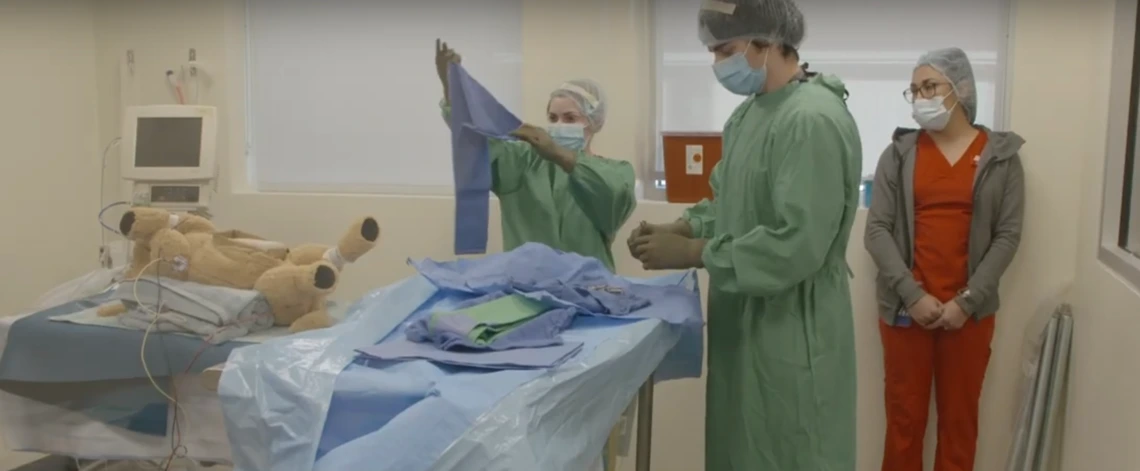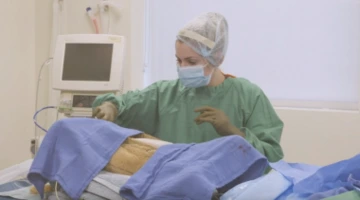Preparing Surgically Skilled Practitioners
Second-year students are kicking off the year immersed in realistic surgical simulation environments.

Second-year students at The University of Arizona College of Veterinary Medicine are kicking off the year immersed in realistic surgical simulation environments to develop and prepare their emerging surgery and anesthesia skills for their upcoming clinical year. Throughout their anesthesia and surgery course, students get to experience and learn how to solve the most encountered anesthetic and surgical complications before tackling the real thing in the College’s mobile surgery clinic.

Students begin their surgical journey in a series of hands-on labs that enable them to perform and refine the technical skills needed for upcoming simulations and required for live-animal surgery. The first portion of the class is taught predominantly by utilizing models, mannequins and simulated vital signs incorporating extremely realistic scenarios that draw students into the case. Students experience a similar sense of urgency to a live-animal surgical experience, but within a safe environment for learning. While simulations depict the most common anesthetic and surgical challenges seen in clinical practice, the scenarios are also embedded with unforeseen complications. Allowing students to experience unanticipated pressure helps students learn how to manage their emotions and respond effectively to a rapidly changing patient. Simulations provide a realistic anesthetic and surgical environment with tight time constraints, which help equip students with the necessary skills to manage similar live-animal cases and the insight to know when help is necessary. Ultimately, the process “helps prevent students from freezing in live-animal surgery,” relays Dr. Robert Keegan, anesthesiologist and Professor of Veterinary Medicine.
During the second week of class, students begin interacting with the immersive simulations. To aid the learning process, students are organized into groups of eight and, for the duration of a given scenario, take on the role of a participant or an observer. Students assigned the role of a Participant fulfill the duties of either an anesthesia provider or a surgeon and then switch to the opposite role for the following week’s simulation. At the same time, students assigned as Observers watch and analyze the surgical simulation via livestream, and assess the challenges encountered by the participants in the first simulation. While the second group gets to learn from their classmates’ choices and apply their decision-making skills to a similar second iteration of the simulation, they will encounter different unexpected complications than the first group.
At the start of each scenario, the acting anesthesia providers begin the procedure by connecting monitors and anesthesia equipment to the canine mannequin. The patient is then monitored by the anesthesiologist during the 15-minute simulation, where they are expected to respond to vital sign changes and ensure the patient’s stability and safety. The surgeons, meanwhile, begin by donning surgical gloves and gowns and applying surgical drapes on the patient. Upon consultation with the anesthesia team, the surgeons make an incision and perform the procedure. Each scenario is layered with deliberate practice techniques that build upon each other. As a result, students develop fluidity, speed and decision-making abilities in a stressful surgical environment. The lessons learned and experience gained in the simulations bolster confidence and set students up for success during live-animal surgical procedures.
At the conclusion of the 15–20-minute simulation exercise, the student participants, together with the simulation instructors, join the observing students in the debriefing room to unpack the simulation and discuss decisions and actions. The debriefing session, typically twice the length of the actual simulation, combines participant reflection with instructor and observer insight and is a critical part of student learning and retention. Over the course of their anesthesia and surgery class, students will conduct multiple simulated surgeries with increasing complexity, preparing them to apply their skills in the College’s mobile clinic.
The immersive nature of the simulations with their immediate feedback provides a sense of realism, so much so that students report their own heart rates increase when simulated patients develop cardiac arrhythmias and scenarios get tense. “Part of simulation,” said Keegan, “is getting people a little bit out of their comfort zone so that learning is enhanced, but not overloaded to the point that they shut down.” Learning under controlled stress allows students to practice, remember, and make decisions more effectively compared with traditional educational models, and having an opportunity to experience each essential position gives students a more well-rounded understanding of the surgical environment.
With the confidence and know-how gained in the simulations, our future veterinarians will step out of the simulation lab and into the College’s mobile surgery unit. The 54’ long mobile surgical facility provides students closely supervised instruction in live-animal surgery while serving the pet population of local animal shelters by improving their adoptability. The spay and neuter procedures are crucial and afford the students real-life anesthesia and tissue handling experiences that are impossible to perfectly duplicate with simulation.
"In order to get. . .proficient at surgery, you [have to] to do it a lot [to gain the requisite skills]. It takes a variable amount, depending upon the student, but there is a [sort of] minimum number. [It seems that students begin to understand what they are doing] somewhere around 10 or 12 surgeries. . .but they probably are not proficient until they do four times that number. The big benefit of the mobile clinic is that it allows them to do a lot of these surgeries, a lot of the repetitive things. The intent is just to get them a surgical experience,” Dr. Keegan shared.
After this period of intense skill development, students will take their newly acquired anesthesia and surgery capabilities with them into their clinical year. Working under the supervision of adjunct faculty and partnering practitioners at clinical affiliates throughout the region, students will spend their final year of veterinary school in clinical practice gaining invaluable experience in medicine and surgery. Equipped with this experience, students will embark on their careers as day-one-ready veterinarians.
